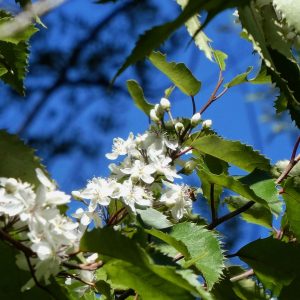New Zealand Lacebark (Hoheria populnea), an understorey tree bearing striking white swathes of autumn flowers, followed by winged seeds.
A member of the Mallow family, Hoheria was adopted into late Victorian horticulture, planted at the major botanic gardens, on bayside properties and at hill stations like Alton, north of Melbourne in the Macedon Ranges. It was also briefly promoted as a potential fibre plant (an alternative common name is New Zealand Ribbonwood), though interest appears to have been fleeting.
As new wealth followed road improvements to seek the hill station lifestyle in the Dandenong Ranges, the tree featured in several notable ranges gardens, including Burnham Beeches (developed by Alfred Nicholas, whose brother George had purchased Alton in the 1929). Broader adoption into residential horticulture would follow in the 1940s and 1950s, with glowing coverage in newspaper gardening columns echoing the tree’s improved availability from growers. Hodgins and Warners are both said to have included Hoheria in their displays in this period; in 1954 the Age would describe it as ‘among the finest of the smaller evergreen trees,’ and ‘rapidly gaining in popularity for use in suburban gardens—particularly in seaside districts.’
In the Dandenongs, NZ Lacebark has found environmental conditions close enough to its North Island home range to begin to establish in damaged wet forest landscapes along the valley of Sassafras Creek. Here, occasional collections began in 2000, cropping up as individuals or small groups which blend in with the native understorey until they burst into flower in late March.
In NZ, adoption into modern horticulture has seen this tree spread south from its indigenous range on the North Cape. It has also shown up in 2016 in South Australia on a weedy drain below the Mount Lofty Botanic Gardens, and there are scattered records from California and the north of England.
The two photos of the winged seeds are courtesy Dylan Osler ( @ecological_perspective ), who put me onto this tree a year ago.
View Original Post on Instagram
Search for information about Hoheria populnea in the Flora of Victoria
View information and occurrences of Hoheria populnea on the Atlas of Living Australia










